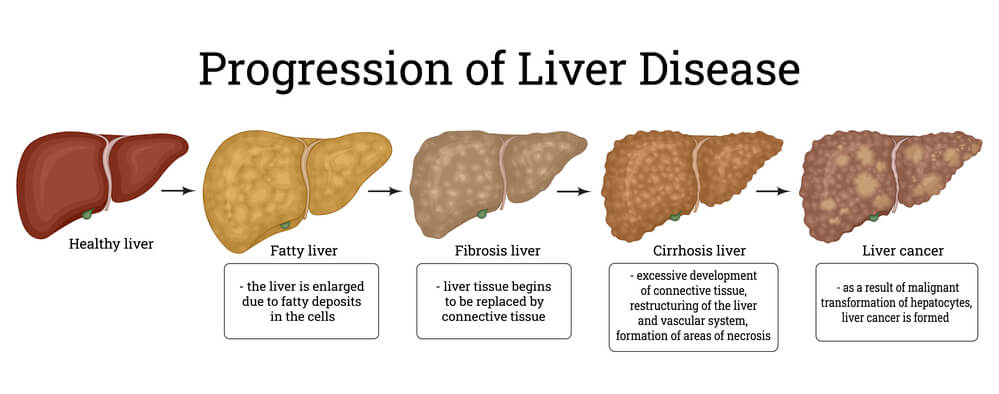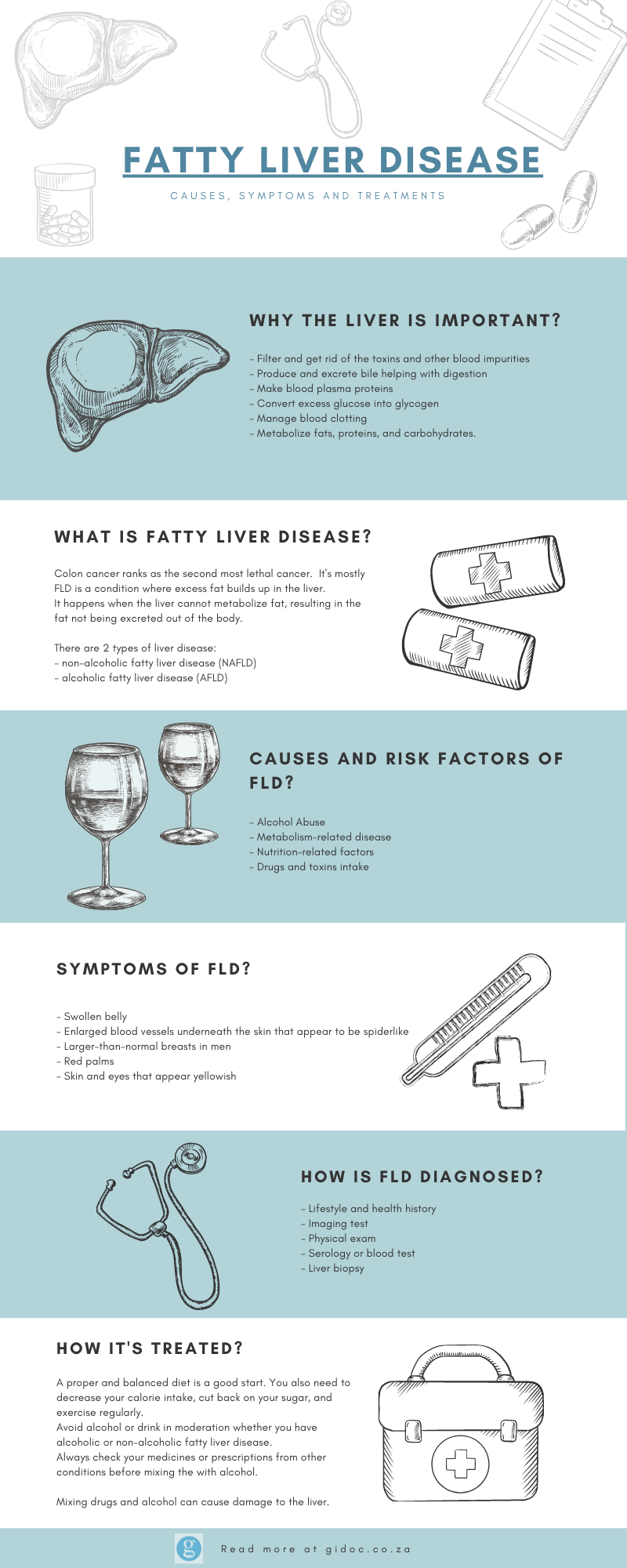After a long week’s work, all you want to do on a Friday night is to eat out, drink, and have fun with your colleagues or friends.
The night gets long, you go home tired, and while resting, your liver works harder.
The liver is the body’s largest internal organ which is about the size of a football. The liver is the body’s blood purifier. Without it, our bodies will be filled with toxins that will make us sick.
Its primary functions are to:
- filter and get rid of the toxins and other blood impurities;
- produce and excrete bile that helps with digestion by breaking down fat in the small intestine;
- make blood plasma proteins;
- convert excess glucose into glycogen for storage that can be later turned back into glucose for energy as needed;
- manage blood clotting; and
- metabolize fats, proteins, and carbohydrates.
Because of these functions, the liver is one of the organs that are most subject to abuse and damage. One of the most common liver diseases is the fatty liver disease (FLD) or hepatic steatosis.

What is Fatty Liver Disease?
FLD is a condition where excess fat builds up in the liver. It happens when the liver cannot metabolize fat, resulting in the fat not being excreted out of the body.
There are two types of FLD: non-alcoholic fatty liver disease (NAFLD) and alcoholic fatty liver disease (AFLD). By the names of it, NAFLD is acquired by those who drink little to no alcohol and the latter is from consuming too much alcohol over time.
Fatty liver is actually the earliest stage of liver disease.
Having a fatty liver is not life-threatening, but neglecting this condition can lead to other more serious conditions such as liver cirrhosis and even cancer.

What are the Causes and Risk Factors of FLD?
The excess or build-up of fat in the liver can be caused by various habits and medical conditions. The causes can be:
- Alcohol Abuse
When metabolizing alcohol in the liver, toxic metabolites are produced. This commonly happens to chronic alcoholics.
- Metabolism-Related Disease
FLD can be caused by existing disorders such as abetalipoproteinemia or the disorder when proper absorption of fat and fat-soluble vitamins from food is obstructed.Another example is glycogen storage disease when the synthesis or metabolism of glycogen is affected by enzyme deficiencies.Because heh body is an interconnected system of organs, problems with metabolism can affect the liver and cause FLD and other liver diseases.
- Nutrition-Related Factors
Obesity or excess accumulation of fat in the body can also cause FLD. Other factors include high blood sugar, insulin resistance, and high levels of triglycerides in the blood.Triglycerides are also known as lipids or a type of fat. When you eat, the calories that your body does not immediately need are converted to triglycerides and stored in fat cells. These are later released for your body’s energy in between meals.Rapid weight loss and malnutrition can also cause FLD.
- Drugs and Toxins Intake
Fatty liver disease can sometimes be a side effect of medications and drug intake, as well as exposure to toxins.
While chronic alcohol intake is one of the major causes of FLD, some people develop FLD even when they do not have the mentioned habits and medical conditions.
Some factors increase the risk of having a fatty liver including the following:
- obesity
- chronic viral hepatitis
- genetics
- old age
- removed gallbladder
- polycystic ovary syndrome
- sleep apnea
- type II Diabetes
- hypothyroidism
- hypopituitarism
How Serious is a Fatty Liver?
If fat is detected in the liver biopsy but the liver is not swollen and has no tissue damage, the diagnosis may be non-alcoholic fatty liver disease (NAFLD).
This is a simple fatty liver and nothing serious. But you need to treat it before it develops into serious liver diseases.
Non-alcoholic steatohepatitis or NASH is one of the serious liver diseases.
It is diagnosed if you have fat in the liver, and the organ is swollen and damaged.
When liver damage from NASH is left untreated, it can lead to much more serious liver diseases like cancer.
Permanent scarring (fibrosis) to the liver that causes it to harden is cirrhosis or liver cancer.
In a 2010 study of NAFLD in Western Cape, South Africa, 48% of the 233 screened patients had NAFLD, of whom 36% had NASH and 17% had advanced liver fibrosis.

What are the Symptoms of FLD?
FLD usually gives no symptoms. People often learn about their fatty liver because of medical exams for other reasons or during their annual physical and medical tests.
The liver is situated in the upper right abdomen, below the lungs, and on top of the stomach. This is the part that throbs, hurts, or feels tired that may indicate damage to the liver.
In cases of fatty liver disease that has developed into a serious condition like non-alcoholic steatohepatitis (NASH), the following symptoms may be experienced:
- Swollen belly
- Enlarged bloodvessels underneath the skin that appear to be spiderlike
- Larger-than-normal breasts in men
- Red palms
- Skin and eyesthat appear yellowish.
How is FLD Diagnosed?
You may experience no symptoms that will directly relate to fatty liver disease so it is best to have yourself checked annually or whenever you deem necessary.
Detection of a probable FLD can be through a blood sample or an imaging test.
If there is something unusual in the blood test results or the liver appears slightly enlarged in an imaging test, your doctor may recommend the following procedures to diagnose FLD:
- Lifestyle and Health History
Your doctor may ask about your alcohol drinking habits, eating habits, and if you have relatives who had liver diseases. Your doctor may also ask about your other medical conditions that may have caused FLD.
- Imaging Test
Fat in the liver appears bright in an ultrasound. Other imaging tests such as CT scans or magnetic resonance imaging can also show fat in the liver.
- Physical Exam
Your doctor may inspect your body and look for symptoms such as swollen belly or jaundice, a condition that causes a yellow pigmentation in the skin and the sclera (white part in the eyes), among others.

- Serology or blood test.
High levels of specific enzymes indicate a problem in the liver.
Serology is also used to eliminate possibilities of other diseases such as hepatitis.
- Liver biopsy.
Your doctor may recommend this if a serious condition of fatty liver disease is suspected.
In a liver biopsy, a sample of liver tissue is collected and examined.
It is also best to talk to your doctor about other symptoms you may have been experiencing like fatigue, loss of appetite, etc.
You can also ask your doctor about clarifications and the next steps if you will be diagnosed with FLD.

How is Fatty Liver Disease Treated?
A simple case of fatty liver disease can be treated by correcting habits and making lifestyle changes to control fat accumulation in the liver.
A proper and balanced diet is a good start. You also need to decrease your calorie intake, cut back on your sugar, and exercise regularly.
Avoid alcohol or drink in moderation whether you have alcoholic or non-alcoholic fatty liver disease.
Always check your medicines or prescriptions from other conditions before mixing them with alcohol. Mixing drugs and alcohol can cause damage to the liver.
If you drink heavily or think you are suffering from alcoholism, you can confidentially disclose this to your doctor.
This way, your medication and treatment can address both the fatty liver disease and alcoholism and other issues that may hamper your recovery and affect your overall health.
Contact Dr. Deetlefs today for an appointment in Cape Town.
DISCLAIMER: PLEASE READ CAREFULLY
The information on this website is to provide general guidance. In no way does any of the information provided reflect definitive medical advice and self-diagnoses should not be made based on information obtained online. It is important to consult a Gastroenterologist or medical doctor regarding ANY and ALL symptoms or signs including, but not limited to: abdominal pain, haemorrhoids or anal / rectal bleeding as it may a sign of a serious illness or condition. A thorough consultation and examination should ALWAYS be performed for an accurate diagnosis and treatment plan. Be sure to call a physician or call our office today and schedule a consultation.
© Dr. Eduan Deetlefs, Registered Gastroenterologist, GI Doc Cape Town
Our website information is not intended or implied to be a substitute for professional medical advice, diagnosis or treatment. Please consult a doctor about your specific condition. Only a trained physician can determine an accurate diagnosis and proper treatment.


